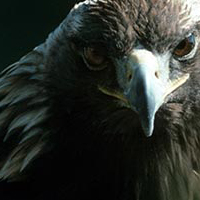Golden Eagle
Scientific name: Aquila chrysaetos

Cover photo credit: JD Taylor
Status
Endangered
Endangered
means the species lives in the wild in Ontario but is facing imminent extinction or extirpation.
Date added to the Species at Risk in Ontario List
The Golden Eagle was already assessed as endangered when the Endangered Species Act, 2007 took effect in 2008.
Read the most recent assessment report [PDF]
What it looks like
Golden Eagle is one of Ontario’s largest and most powerful birds of prey. The species is named for the golden-brown feathers on the back of its neck, head and upper wings, but the rest of the body is mostly dark brown.
Young birds have lots of white visible on the base of the tail and in the interior of the wing, but this white will largely disappear by their fifth year.
Juvenile Bald Eagles can look very similar to Golden Eagles, however, the legs of the Golden Eagle are completely feathered while the legs of the Bald Eagle have no feathers immediately above the feet.
When soaring, Golden Eagles hold their wings slightly above the horizontal and show less head and neck and a longer tail than the Bald Eagle.
Where it lives
Golden Eagles nest in remote, undisturbed areas, usually building their nests on ledges on a steep cliff or riverbank, but they will also use large trees if needed.
Most hunting is done near open areas such as large bogs or tundra. During migration they could be encountered anywhere, but are most frequently seen migrating west along the shores of Lake Ontario and Erie in November.
Small numbers also winter in the southern half of Ontario, most often near large deer wintering areas where carcasses might be found.
Where it’s been found in Ontario
In Canada, Golden Eagles are most common in the western mountains and prairies but are also fairly widespread in Labrador and Quebec’s Ungava peninsula.
In Ontario, breeding Golden Eagles are presently known only from the Hudson Bay Lowland, although there is some evidence suggesting they once nested much further south.
Currently there are believed to be 10 to 20 breeding pairs in the province.
What threatens it
Golden Eagles are very sensitive to disturbance near their nests, for example, due to hiking, boating or noise from nearby developments. They can abandon their nests if harassed or kept away from the eggs or young too long.
While the threat to their habitat from fire suppression and forestry is low in Ontario, other resource extraction activity, such as X and Y may threaten their habitat.
They have also suffered greatly from human persecution, such as illegal shooting and trapping, although with improved attitudes toward predators in general, these problems have diminished greatly in recent decades.
Electrocution on power lines is a continuing problem in western North America, and collisions with wind turbines have been documented at some sites.
The Golden Eagle can also be harmed by chemicals and toxins in the animals that it eats.
Climate change and the resulting shift in weather patterns may impact breeding success and migratory patterns.
Action we are taking
This species and its habitat are protected under Ontario’s Endangered Species Act, 2007 (ESA).
The ESA also requires us to prepare recovery guidance for endangered species such as Golden Eagle to guide recovery efforts for the species in Ontario.
All species listed on the Species at Risk in Ontario List may be eligible for consideration for government funding through the Species at Risk Stewardship Program.
Recovery strategy
A recovery strategy advises the ministry on ways to ensure healthy numbers of the species return to Ontario.
Read the executive summary (March 2, 2015)
Read the recovery strategy (March 2, 2015)
Government response statement
A government response statement outlines the actions the government intends to take or support to help recover the species.
Read the government response statement (March 23, 2016)
Review of progress
A review of progress made toward protecting and recovering a species is required no later than the time specified in the species’ government response statement, or not later than five years after the government response statement is published if no time is specified.
Read the report on progress towards the protection and recovery of 18 species at risk, including Golden Eagle (2021).
Habitat protection
General Habitat Protection - June 30, 2008
What you can do
Report a sighting
Submit your observations of species at risk to the Natural Heritage Information Centre (NHIC), which is Ontario’s conservation data centre. Join the "(NHIC) Rare Species of Ontario" project in iNaturalist to make submitting your observations quick and easy.
Volunteer
Volunteer with your local nature club or provincial park to participate in surveys or stewardship work focused on species at risk.
Be a good steward
Private landowners have a very important role to play in species recovery.
If you find species at risk on your land, you may be eligible for stewardship programs that support the protection and recovery of species at risk and their habitats.
Learn more about the Species at Risk Stewardship Program.
Report illegal activity
Report any illegal activity related to plants and wildlife to
Quick facts
- Increasing numbers of sub-adult Golden Eagles are spending the summer along the Hudson Bay coast, where they hunt the abundant snow goose at their nesting colonies.
- The Golden Eagle has a wingspan of just over two metres and can weigh as much as six kilograms.
- The number of Golden Eagles being seen at traditional Ontario hawk migration monitoring stations has increased greatly in the past two decades. In the fall of 2008, several stations on Lake Ontario and Erie reported more than 50 in one day – a number that would have seemed unbelievable even a decade ago.